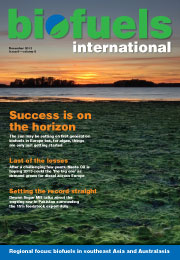
Volume 6, Issue 9
Published: November 2, 2012
NYC warms up bioheat enthusiasm as US biodiesel nears mandate
Even with sluggish demand for distillate fuels in the US this year, which is trailing the 2011 consumption rate by 3.7% through mid-October, US biodiesel producers had something to cheer in opening the...
Another five-year wait
The much awaited announcement from the European Commission came in mid-October revealing that fuel suppliers will not be accountable for indirect land use change (ILUC), but confirming that it will stick...
European clash of the year
To counter-act allegations of spreading false rumours and involvement in fraudulent actions in regard to biodiesel origin and custom tariffs, Norwegian producer Uniol will take legal action against the...
Making the price right
KLM ambitiously set out a goal to increase its biofuel consumption to 1% of its total fuel use by 2015. Considering biojet fuel is three to four times the price of fossil fuel, this is no easy task. ‘From...
Project Thunderbird is go
Across Native American tribal lands from Washington to New York, a new bioenergy initiative is underway named Project Thunderbird. The aim of the project is to build $3 billion (€2.3 billion) worth...
Riding the rollercoaster
Although a number of southeast Asian countries have introduced minimum biofuel blending mandates, not all governments have succeeded in enforcing them, with biofuel producers in some countries exporting...
Four times a charm
What is large, green and been causing ripples on a global scale? Nope, we’re not talking about the re-emergence of comic book character The Incredible Hulk but of the humble organism algae, which...
Thai-ing themselves to biofuels
Thailand authorities have this November stepped up the country’s biodiesel programme by raising the compulsory blend ratio of palm methyl ester from 4% to 5% following a previous shortage of crude...
Setting the record straight
The ethanol sector in Pakistan has been the subject of much controversy in recent months, with producers being accused of unfairly insisting on a 15% export tax on the feedstock molasses to discourage...
Weeding out Scottish fuels
Since news that Europe may be capping foodbased biofuels at 5% of the total amount of renewable energy used in transport, interest in alternative non-food feedstocks such as marine biomass has exploded....
Combining two proven technologies
As the ethanol industry continues to search for methods and technologies that improve margins in a high-input cost industry, several key aspects of these improvements require evaluation. Proven performance,...
Scaling up step by step
The recommended approach for scaling bioenergy and biofuels technology follows a similar stage gate process to that used in traditional Chemical Process Industry (CPI) processes. But the processing leads...
Time for change
The world is changing faster and faster every day. Paper, fax machines and landline phones are something from the last century. For babies that are coming into the world in developed countries right now,...
Last of the losses
Neste Oil saw Asian palm as an advantageous feedstock platform for renewable diesel years ago and has used the feedstock to build one of the leading biofuels operations in Europe. It has been included...
Who takes the blame?
Feeling the heat of RFS waiver requests from food and feed producers over high corn and soyabean prices, biofuels stakeholders have said blame should really be placed on ‘speculators’ –...
Co-products key to profitability for US ethanol producers
US ethanol producers continue to become more diversified in the types of products they refine for sale, thus improving their ability to sustain profits in times of high feedstock costs and relatively low...
Comparing the new with the old
If a biodiesel feedstock has higher free fatty acid (FFA) than say 1%, a preprocessing step has to be deployed to be able to either eliminate or reduce the amount of FFA in the oil which then could be...
Amperometric detection
Today many biodiesel manufacturers use an alkali catalyst in the transesterification process as reaction rates under acid or enzyme catalysts are relatively slow in comparison. Incomplete reaction leads...
Automating analysis
Biodiesel sold within the EU must fulfill several quality criteria in order to avoid damages to modern diesel engines. All relevant parameters, their limits and the appropriate test methods for determination...
Establishing the economics
Despite a tremendous amount of research that has been carried out on lignocellulosic feedstocks, the technology is still not available on a commercial scale yet. This success very much depends on multiple...
Increasing bioethanol yields with solid-state fermentation products
Industrial applications such as bioethanol and animal nutrition require an ever-wider variety of raw materials. This long-term trend calls for the creation and development of increasingly elaborate biocatalysts....










